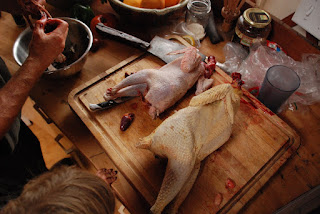
I seem to be having difficulty regularly posting here. It's largely due to the new habits of my three-year-old. She no longer naps in the afternoons, leaving me without my mid-day space out, web-surfing moment, in which I have written a lot of my posts. I also used to write a lot after she went to bed, or even in the evening while she was playing with her dad, but the computer is now occupied with her nightly obsession with Angelina Ballerina, or one of her other DVD's, until we are all dead tired at about 9 PM. That pesky time change leads us all to the barn earlier these days.
Anyhow, back on topic, the subject of my post today is the larder, particularly how excited I am to take stock of the wares I've canned, accumulated, dried, grown or otherwise stashed for our family's consumption between now and April and beyond. The weather of winter has fully and completely arrived, meaning very short days, regular cold, cloudy, and rainy days, and cold nights. I've noted over the years here that all growth of plants basically stops, or progresses painfully slowly, during these months. Even though many of our local plants don't die back as in places where it snows, many do, while others simply pause as if mid-sentence, and wait for longer days and warmer nights to begin to stretch again. Even the grass tends to pause.
While the garden and native plants are stuck in winter limbo, we still have plenty to eat, though not as great a quantity of fresh produce as in the summer. Here is a list of what I've canned up to line our (forthcoming) pantry shelves:
2 cases of tomato
6 tomato paste
10 zucchini relish
35 or so jars of jam (apple ginger jelly, blueberry, strawberry, peach, and blackberry)
16 quarts of apple juice
1.5 cases of red tomato salsa
2 cases green tomatillo salsa
~12 tubs of pesto (frozen)
about 30 winter squash
6-8 cups of dried white beans
dried herbs
two frozen chickens whole
a several month supply of cured garlic
about 8 cups of home grown wheat berries
frozen strawberries
locally-grown frozen beef
I still have yet to can/put up:
pumpkin
green tomato chutney
saurkraut
Even though it's winter outside, we're still eating:
fresh cabbage
fresh carrots
fresh broccoli
fresh greens
fresh beets
the dregs of the tomato, eggplant, and peppers
I don't think our garden produce will last through like I always try to manifest, but it will only be a few months where we won't have anything.
Days left until the first spring planting: About 90.
























